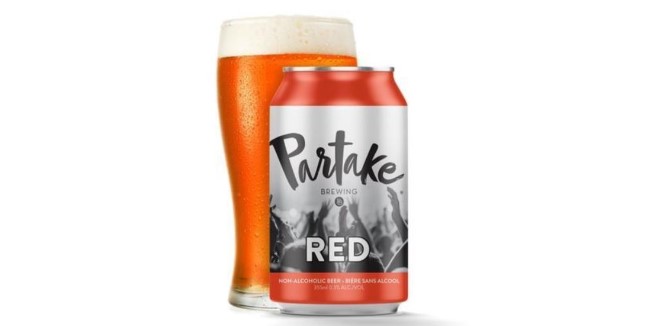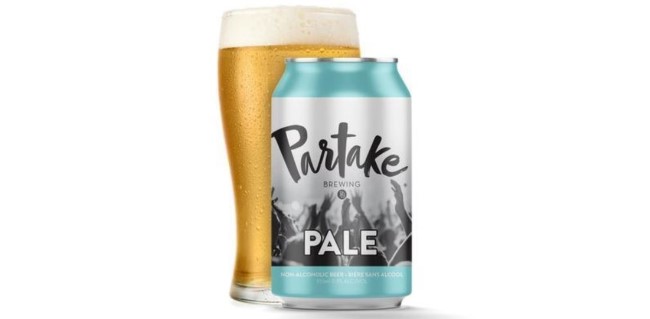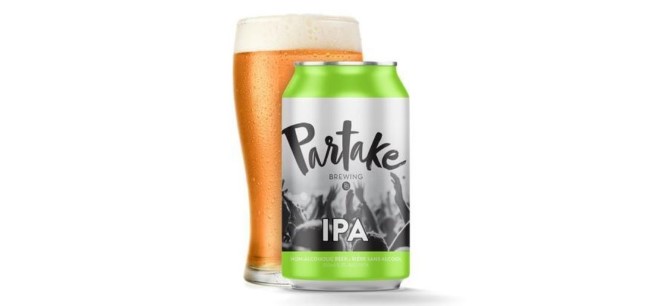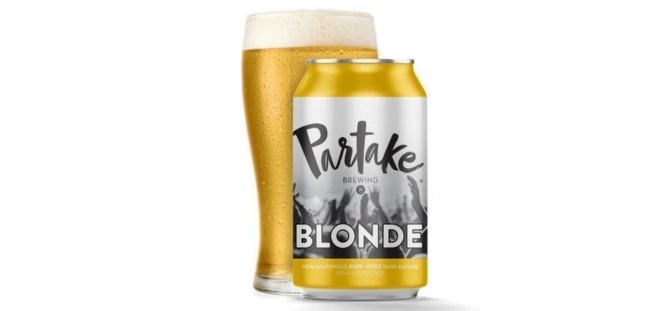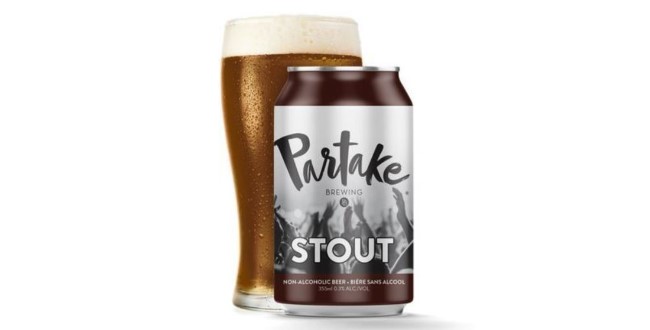Tasting: 5 Non-Alcoholic (Extremely Low Calorie) Craft Beers from Partake Brewing
Photos via Partake Brewing
In the last two years, I’ve become more well versed in the world of non-alcoholic beer than I ever imagined I might become. If you’d asked me in my mid-20s if I’d ever be regularly consuming non-alcoholic lager, IPA or stouts, I’d have thought that you were dreaming. But now, in my mid-30s, I’m thankful for the increasingly wide variety of palatable options for decreasing one’s overall alcohol consumption. Will we ever get to a point where there’s N/A beer on the shelf that is truly indistinguishable from the real thing? Perhaps not, but the results are improving each and every year, and N/A beer sales continued to grow in 2020 even as the beer industry contracted as a whole. Where only five years ago, you might have struggled to find a single beer described as a “non-alcoholic pale ale” that was worth drinking, now there’s a plethora.
And as the N/A marketplace has filled out, with major brands like Heineken 0.0 or Bud Zero at the top, and craft players such as BrewDog,Athletic Brewing Co. and WellBeing Brewing offering a wider array of N/A styles, a new normal has slowly coalesced. Many of these brands are offering an array of styles you might describe as “American brewpub classics,” such as pale ale, IPA, wheat beers, amber ales and stouts. A few have branched off into more novel and unusual directions, such as non-alcoholic Belgian-style ales, or even non-alcoholic sours, but these are still essentially the bleeding edge of N/A craft, off in the horizon for most drinkers.
Another thing you’re likely to notice, as you sample these N/A brands—they’re all lighter in calories than standard beer styles, thanks to the lack of alcohol. It’s another convenient selling point for N/A beer, so often aimed at health-conscious consumers, because the majority of these brands tend to be between 50 and 90 calories for a 12 oz serving.
That’s also, however, why my eyes just about popped out of my head when I saw the following from Canada’s non-alcoholic Partake Brewing: An N/A IPA with only 10 calories. That, and another N/A pale ale with 10 calories, flanked by a blonde ale with 15 calories, a red ale with 25, and a “dark” ale with only 30. The entire Partake core lineup, in fact, falls between 10 and 30 calories for each 12 oz serving, which seems ludicrously low. At this point, we’re pretty much effectively in “beer flavored La Croix” territory. Think of it this way: There’s actually fewer cumulative calories in an entire six-pack of Partake IPA than there is in a single bottle of Heineken 0.0. That’s how nutty this is.

I was immediately curious of two things: How are these low calorie counts possible, and how do they compare to some of the other, popular N/A beer brands on the shelves? Curious about the former, I reached out to the company and spoke to founder Ted Fleming. As for the latter, here’s a smattering.
— Heineken 0.0: 69 calories per 12 oz.
— Bitburger Drive: 73 calories per 12 oz.
— Budweiser Zero: 50 calories per 12 oz.
— Athletic Brewing Co. beers: Roughly 50-90 calories per 12 oz, across a variety of styles.
— WellBeing beers: Roughly 63-96 calories per 12 oz across a variety of styles.
— BrewDog N/A beers: Roughly 21-77 calories per 12 oz across a variety of styles.
Of all those obvious competitors, only BrewDog produced a beer (Nanny State) with a calorie count in the same ballpark as Partake, but even they aren’t offering cans of IPA that can brag of being a mere 10 CALORIES, a number so small it can barely be said to exist at all. It does make one wonder, what is Partake doing differently?
Partake is a Canadian brand, contract brewed at several facilities in Toronto and Calgary, Alberta, but it seems like the U.S. is intended as its primary market. It’s currently distributed on some level in up to 22 states, including major markets in Washington D.C., southern California, Texas, New York and Colorado. You can find it at retailers such as Total Wine and Wegman’s, and it is now available online in the majority of states, given that online N/A beer sales are easier to conduct for obvious reasons. There’s a few other, little distinctions, such as the fact that the Canadian version of one beer is called “Stout” while the U.S. version is called “Dark” thanks to TTB rules, but other than this it’s pretty much a consistent portfolio.
The difference of course rests in the production process, where Partake is using a method called “arrested fermentation” to achieve such comically low calorie counts, while simultaneously trying to preserve a satisfying flavor profile. To understand how this works, you sort of need to understand how most non-alcoholic beer is made.
Traditionally, N/A beers are make via dealcoholization, which entails simply brewing a standard beer and then removing the alcohol from it with a thermal process, or vacuum-assisted thermal process. For decades, this is how pretty much all N/A beer was made, and it’s safe to say these processes were also responsible on some level for N/A beer’s reputation for poor flavor. In recent years, new methods of dealcoholization have also included more gentle micro filtration, which is separation on a molecular level without applying heat.
In Partake’s case, though, it’s an entirely different method, arrested fermentation. Here, the wort is allowed to start fermenting like normal, albeit with a smaller amount of fermentable sugars than would be used to create a standard beer. The fermentation process is then stopped as the wort is subjected to cold temperatures, before the yeast has been able to fully metabolize available sugars. You’re left with a low-enough alcohol level to qualify as N/A beer (below .5% ABV, and .3% ABV for Partake), and surprisingly few calories. Said founder Ted Fleming: “To be honest, the low end of the calorie count was kind of a surprise to us, because that was never our primary goal. We were just trying to produce flavorful non-alcoholic beer, and the low calorie count was a bonus.”
Which leaves just one major question: How do these Partake brands taste? With so few calories, are they noticeably more watery and thin of body than other, comparable examples of N/A craft beer styles? Does the arrested fermentation process result in beers that taste unpleasantly “wort-y” and unfinished? Is it even possible that a 10 calorie non-alcoholic beer might be in some way satisfying?
I’ll be honest: I walked away pretty pleasantly surprised. Let’s get to tasting.
Partake Red
I genuinely don’t know if I should even call this “red ale” or not, given that the can just says “RED,” but at the very least it’s clearly meant to be an analog to American amber or red ales.
In the glass, this one pours a deep amber red, almost garnet, and close to brown. The nose is malty, with a lot of toast/breadiness and lightly yeasty notes. This strikes me as more of a genuinely “malty” nose than I’ve found in many N/A beers, which often contain a very similar note I’ve come to think of as being predominantly like black tea. I would find this tea note in some of the other Partake beers, but as for the red it has a satisfyingly “biscuit”-like profile.
On the palate, this is pretty dry and quite thin of texture, as almost all N/A beers tend to be, but the flavors come through nicely. There’s a dry toastiness, and hints of roasted nuts. Mildly malty in general, there’s the faintest hint of caramel sweetness and a kiss of herbal hops. I can honestly say that this is among the better “N/A amber ales” I’ve tasted to date, not that this is a particularly loaded field. But I have absolutely sampled worse versions of this style of non-alcoholic beer that had three times the calories, so I find this pretty impressive.
Partake Pale
It’s kind of tough to have both a “pale ale” and “IPA” in the same N/A beer family when you don’t have a variable alcohol level to help differentiate them, which in my experience can often make these beers taste “same-y.” This is true of the similar pale ale and IPA from Partake, although both turn out to be pleasant and drinkable.
Partake Pale is lightly toasty on the nose, with moderate hop notes of orange marmalade and fresh grass clippings. It’s a pretty classic profile, harkening back to the pale ales of yore, when a modicum of malt balance was the expectation for this style. On the palate, I get some of that black tea-like maltiness, along with a bit of toffee (but still fairly dry), mellow pine, fresh grass and hints of bitter orange pith. Bitterness is present, but fairly mild in comparison with the IPA. This honestly is quite close in profile to a classic, old-school pale ale, to the point that I would never guess the can had only 10 calories. I seriously expected that calorie count to prove a bigger handicap to these beers than it ends up being.
Partake IPA
Darker in color that one would expect from any modern representation of IPA, this one pours a dark orange in the glass. The nose is pleasant, with moderately assertive notes of citrus, herbs, pine and light florals. It has a nicely “fresh” quality that I’d liken to a just-opened bag of hop pellets, for the homebrewers in the audience.
On the palate, I get some of that black tea maltiness, and a bitterness that seems slight at first, but then grows in intensity over time. The hop flavors don’t translate to the palate as nicely as they do to the nose, leaving this one with more of a general pine/grassiness hop profile. On repeated sips, the bitterness progresses to a somewhat more intense level, which obviously marks this as an IPA in more of a throwback mold than anything influenced by modern hazy/juicy IPA. I don’t think this one is balanced quite as nicely as Partake Pale, but it’s still comparable to most of the N/A IPAs I’ve sampled in the last year, many of which have six or seven times the amount of calories. Again: That’s unreal.
Partake Blonde
This, for me, is where the “arrested fermentation” process is likely falling flat. In a beer style without bigger malt or hop flavors to stand out in an assertive way, “blonde ale” is perhaps not quite as well suited to Partake’s process, which leaves the drinker focusing on some of its more unusual aspects.
On the nose of Partake Blonde, I get a lot of lemon, into some unexpectedly dank hop notes. On the palate, it takes on more of a cereal graininess that is somewhat wort-y, but the thing that then grabs your attention is an unusual fruitiness that reads as artificial and distracting—it honestly left me thinking about Fruity Pebbles or Trix cereals, of all things. Tasting this one had me flashing back to first sampling Leinenkugel’s Sunset Wheat in college, and wondering “did someone flavor this with Trix?”
All in all, this one is easy to drink, but its flavors seem in conflict with one another. It’s the weakest of the varieties I tried.
Partake Dark
Partake Dark, labeled as “Stout” in Canada but not here, is perhaps more accurately labeled in the U.S. than it is abroad, as the beer reminds one of styles such as dunkel or brown ale more than it truly does stout. It doesn’t have the true roastiness to evoke most stout styles, but it does offer a nice change of pace.
On the nose, I’m reminded of roasted hazelnuts and toasted bread crusts, with dunkel-like breadiness and hints of nuts underneath. The palate is dry and nutty, with hints of a slightly licorice-like spiciness, whereas the “black tea” maltiness here takes on a more oxidized sort of dimension, such as Oolong. It’s lacking the fullness of body that some might want in a beer that bears this appearance, but the overall effect is a nicely dry, toasty, nutty brew that would likely appeal to those who enjoy American brown ale or lighter porters.
Jim Vorel is a Paste staff writer and resident craft beer geek. You can follow him on Twitter for much more drinks writing.
